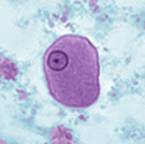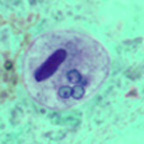

Entamoeba hartmanni (Nonpathogen)
Organism:
This organism belongs to the amebae, is a nonpathogen, and causes no disease. Both the trophozoite (usual size, 4-12 µm) and cyst forms (usual size, 5-10 µm) can be found in clinical specimens.


Trophozoite <12 microns Cyst <10 microns
Life Cycle:
Large bowel, organisms passed in feces
Acquired:
Fecal-oral transmission via cyst form; contaminated food and water
Epidemiology:
Worldwide, primarily human-to-human transmission
Clinical Features:
None
Clinical Specimen:
Intestinal: Stool
Laboratory Diagnosis:
Intestinal: Ova and Parasite examination (concentration, permanent stained smear); E. hartmanni will be identified based on size differences (differentiate from the Entamoeba histolytica/E. dispar group).
Organism Description:
Trophozoite: Evenly arranged nuclear chromatin, central karyosome, fine cytoplasm (will normally not contain ingested RBCs)
Cyst: Usually contains chromatoidal bars with smooth, rounded edges, mature cyst contains 4 nuclei (often two-nucleated cysts seen).
Laboratory Report:
Entamoeba hartmanni (indicate trophozoites and/or cysts).
Treatment:
None
Control:
Improved hygiene, adequate disposal of fecal waste, adequate washing of contaminated fruits and vegetables
Comments:
E. hartmanni will be differentiated from other organisms in the Entamoeba genus by size differences.